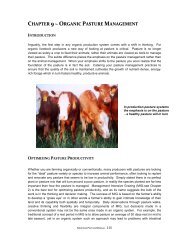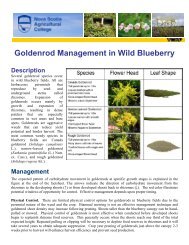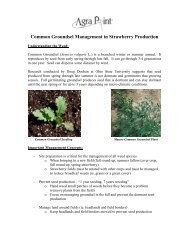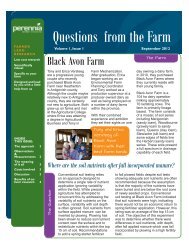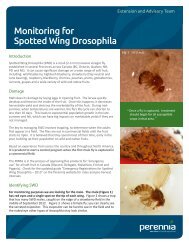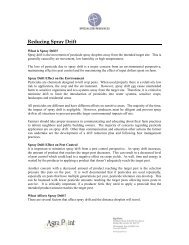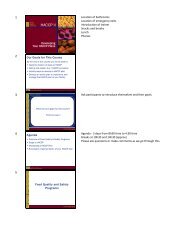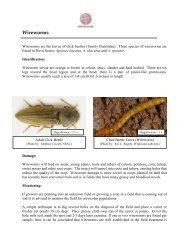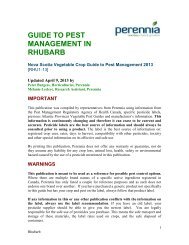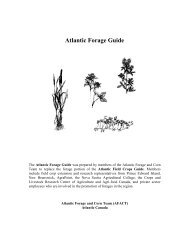Create successful ePaper yourself
Turn your PDF publications into a flip-book with our unique Google optimized e-Paper software.
<strong>March</strong> <strong>2007</strong> Vol 6 Issue 1<br />
10 Webster Street, Suite 210<br />
Town Square, Box 204<br />
Kentville, NS Canada<br />
B4N 1H7<br />
199 Innovation Drive<br />
AgriTECH Park<br />
Truro, NS<br />
Canada<br />
B2N 6Z4<br />
Prepared by:<br />
Jack van Roestel<br />
Field Crops<br />
(902) 678-7722<br />
j.vanroestel@agrapoint.ca<br />
Bill Thomas<br />
Field Crops<br />
(902) 896-0277<br />
b.thomas@agrapoint.ca<br />
CONTENTS<br />
• Upcoming Producer Meetings<br />
• Good Packing for Bunker Silos<br />
• N Timings on Winter Wheat<br />
• New and Improved Forage Test<br />
• Fertilizer Rates for Various Crops<br />
Odds and Sods<br />
Poor Forage & Beef Gains – Sean Firth<br />
mentioned that our recent <strong>March</strong><br />
Feeder Sale of 216 head averaged 85<br />
lbs/head less than the rolling six year<br />
average. This likely reflects the general<br />
poor quality of 2006 forages and<br />
the very high cost of corn and barley.<br />
Many farmers have been commenting<br />
on poor cow condition and lower<br />
milk available to new beef calves in<br />
the past few months. The pasture season<br />
can’t come early enough this year,<br />
but try to wait for 4 – 6 inches of growth<br />
(10 – 15 cm) before turnout or pastures<br />
won’t perform as well.<br />
continued on page 2<br />
<strong>CropLinks</strong><br />
information on<br />
forages, corn and cereals<br />
This issue of <strong>CropLinks</strong> talks about some upcoming producer meetings that are<br />
planned for the next couple of weeks, along with some fertilizer considerations for<br />
various crops (see insert), good packing practices for bunker silos, N timings for winter<br />
wheat and a big Maritime Forage Variety Test that’s being planned for this spring. With<br />
daylight to 8pm and some nice 10-15C days starting to happen, have a read through<br />
<strong>CropLinks</strong> and let’s get ready to rumble.<br />
Get a good pack and reduce spoilage<br />
Bunker silos have several advantages over upright silos however excessive spoilage or<br />
dry matter loss can be a problem. Getting the crop stored at a high enough density in<br />
the silo is an important factor that can minimize dry matter loss and spoilage during<br />
fermentation and feed out. The goal is to compact the silage to a density of at least 17<br />
lbs of dry matter per cubic foot for corn silage and at least 15 lbs for haylage. Simply put<br />
the higher the density the lower the dry matter loss and the more stable the feed is at<br />
feed out.<br />
A recent study at the Wisconsin determined the major factors affecting the density of a<br />
grass or legume crop stored in bunker silo was packing pressure, moisture content,<br />
and chop length, for corn silage it was packing pressure, layer thickness and kernel<br />
processing. Packing pressure is a function of silage depth, tractor weight, and time<br />
packing per tonne.<br />
The following options are suggested for improving compaction during filling:<br />
• Keep harvester knives sharp and chop haylage at 3/8 inch theoretical cut and corn<br />
silage at ¼ inch cut. This should provide enough effective fiber to prevent fat test<br />
depression and yet allow effective packing.<br />
• Fill the silo from the back to the front using a 1:3 or 1:4 slope often referred to as the<br />
progressive wedge technique.<br />
• Decrease packing layer thickness from 12 inches to 6 inches<br />
• Consider adding weight to the tractor by adding fluid to the tires,adding front end<br />
weights, adding steel wheel weights, or adding dual wheels with fluid and or wheel<br />
weights. Increasing tractor weight will increase silage packing density.<br />
• Add an additional packing tractor especially as the pile is nearing completion.<br />
Use a heavier rather than lighter second tractor so as not to reduce the average<br />
tractor weight.<br />
continued on page 2
Spoilage (continued)<br />
• Increase packing time especially during the final two feet. As a general rule the amount of packing time (in minutes) required<br />
per ton of wet silage is equal to 18 divided by the weight of the tractor. For example if the tractor weighs 10 tons then the packing<br />
time required would be 1.8 minutes per ton of wet silage.<br />
Crop and Critter Meetings to Attend<br />
There are some informative grower meetings planned in late <strong>March</strong> and early April which cover improved forage management for beef<br />
& dairy, better dairy feeding efficiency plus corn and cereal production tips.<br />
Improving Forage and Feeding Efficiency on Your Dairy<br />
Farm<br />
<strong>March</strong> 27 th – Coldbrook, Wandlyn Inn (10 am – 3 pm)<br />
<strong>March</strong> 28 th – Port Hawkesbury, Civic Centre (10 am – 3 pm)<br />
<strong>March</strong> 28 th – Scotsburn, Fire Hall (7:30 pm – 10 pm)<br />
<strong>March</strong> 29 th – Shubenacadie, St. Briget’s Catholic Church Hall<br />
(10 am – 3 pm)<br />
The key speaker for this session is Virginia Ishler, the Dairy Herd<br />
Manager for Penn State University. Penn State is one of the leading<br />
dairy feeding researchers in the U.S. Besides her work at<br />
Penn State, Virginia & her husband are in partnership with his<br />
parents, operating a custom heifer raising business and selling<br />
total mixed rations to local dairy producers. Ms. Ishlers’s talks are<br />
on fine tuning silage based rations for dairy cows and considerations<br />
in feeding calves and heifers. Other speakers on this program<br />
are Martine de Graaff (SCIANS) discussing pasture improvement<br />
projects, Dr. Glen Sampson (NSAC) with a new grassland<br />
& pasture herbicide, plus Bill Thomas and Jack vanRoestel<br />
(AgraPoint) handling topics such as bunker silo packing techniques,<br />
“Forage Quality – More Important than Ever”, value of our<br />
Maritime corn & forage testing program and is Bt corn worth the<br />
tech fee? This is a joint program put on by the Soil & Crop Improvement<br />
Association of Nova Scotia (SCIANS) and AgraPoint.<br />
For the day meetings there is a $ 10 registration fee to pay for<br />
lunch.<br />
Please Note that on <strong>March</strong> 28 th in Truro there is also a full day<br />
meeting organized by Clarence Farm Services Ltd. titled “Milk to<br />
the Max! <strong>2007</strong>”. This meeting features Dr. Mike Hutjens, Dr. Ken<br />
Osborne and Joel Cormier. Unfortunately neither Clarence’s or<br />
SCIANS were aware of the scheduling conflict when these meetings<br />
were being organized. Both the <strong>March</strong> 28 th Clarence’s dairy<br />
meeting and our <strong>March</strong> 29 th forage and dairy feeding session in<br />
Shubenacadie should be high quality information exchanges and<br />
dairy farmers in Central Nova are encouraged to attend both.<br />
Annapolis County Soil & Crop Meeting “Let’s Get<br />
Ready for Cropping”<br />
This meeting starts with lunch at 12:30pm ($10 charge) and<br />
follows with presentations from Bill Thomas, Sean Firth, and Jack<br />
vanRoestel (AgraPoint) on N-P-K fertility considerations for grass<br />
forage – barley – wheat – soybeans – corn, improving forages for<br />
beef, the sleighfoot manure technology project, new corn herbicides,<br />
etc. Both the Dairy Club and this Soil & Crop meeting are<br />
open to producers and agricultural service reps in the province.<br />
Annapolis Dairy Management Club Barn Meeting at<br />
Trifarm Holsteins<br />
April 3 rd – David and Pamela Bent’s Farm, North Middleton (10<br />
am – 12 noon)<br />
This morning session will have discussion led by Dave, Daniel<br />
Scothorn (independent dairy nutritionist), Bill Thomas and Jack<br />
vanRoestel (AgraPoint) on 1 st cut forage harvest timings, feeding<br />
for high milk production, bunker silo packing density targets,<br />
wide swath wilting, producing low K dry cow hay, etc.<br />
We’ll start sharp at 10 am with hot coffee and you can join us<br />
for lunch ($10 cost) at the Agricultural office in Lawrencetown<br />
which is part of the Soil and Crop Meeting that afternoon. Bring<br />
your boots it will be muddy around the farmyard in early April. A<br />
big “thank you” to Amy Rose for making the lunch arrangements.<br />
Odds and Sods (continued)<br />
Nitrogen for Winter Wheat – In checking several wheat fields<br />
on <strong>March</strong> 15 – 16 th , there seems to be good winter survival to<br />
date (hopefully we won’t get the heave and thaw conditions in<br />
the next 2 – 3 weeks to cause root system damage). There is<br />
some leaf tip burn showing in many fields from recent wind<br />
chill conditions; however this doesn’t hurt the crop.<br />
Many growers will try to put the 1 st N application on in late<br />
<strong>March</strong> with a carrying frost. For the 1 st N, I like to see about 35<br />
N supplied from 80 kg/ha of 46-0-0 (or 70 lbs/ac). If the 1 st N<br />
is applied in late <strong>March</strong>, the 2 nd N would go the first week of<br />
May and could be in the form of urea again, unless the weather<br />
is hot and windy enough that serious ammonia losses could<br />
occur (in this case use 34-0-0 instead). The 2 nd N application<br />
rate could be around 50-60 N, but this would be reduced if<br />
manure went on at seeding or there was a legume N credit.<br />
New Maritime Forage Variety Test – Bill and I have done a fair<br />
amount of promo work on a new forage variety test that should<br />
include 3 Nova Scotia sites. Through a re-vamped testing<br />
approach there appears to be strong interest from 7-8 forage<br />
companies in having alfalfa, red clover, timothy, brome-orchard-reed<br />
canary grass variety trials planted this May. We’ll<br />
have a much stronger and more current forage variety recommended<br />
list for you in a few years from this effort.



